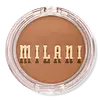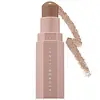What's inside
What's inside
 Key Ingredients
Key Ingredients

 Benefits
Benefits

 Concerns
Concerns

 Ingredients Side-by-side
Ingredients Side-by-side

Dimethicone
EmollientPhenyl Trimethicone
Skin ConditioningSilica
AbrasiveBis-Diglyceryl Polyacyladipate-2
EmollientIsononyl Isononanoate
EmollientMica
Cosmetic ColorantCalcium Sodium Borosilicate
Microcrystalline Wax
Emulsion StabilisingSynthetic Wax
AbrasiveCaprylic/Capric Triglyceride
MaskingSynthetic Fluorphlogopite
Octyldodecanol
EmollientSorbitan Olivate
EmulsifyingCitrullus Lanatus Seed Oil
EmollientRosa Damascena Flower Oil
MaskingTocopheryl Acetate
AntioxidantPunica Granatum Seed Oil
EmollientStearalkonium Hectorite
Gel FormingPropylene Carbonate
SolventPolyglyceryl-6 Polyricinoleate
EmulsifyingCetyl PEG/PPG-10/1 Dimethicone
EmulsifyingPentaerythrityl Tetra-Di-T-Butyl Hydroxyhydrocinnamate
AntioxidantSorbitan Isostearate
Emulsifying1,2-Hexanediol
Skin ConditioningDisteardimonium Hectorite
StabilisingCaprylyl Glycol
EmollientEthylhexylglycerin
Skin ConditioningTriethoxycaprylylsilane
Aluminum Hydroxide
EmollientCI 77891
Cosmetic ColorantCI 77492
Cosmetic ColorantCI 77491
Cosmetic ColorantCI 77499
Cosmetic ColorantDimethicone, Phenyl Trimethicone, Silica, Bis-Diglyceryl Polyacyladipate-2, Isononyl Isononanoate, Mica, Calcium Sodium Borosilicate, Microcrystalline Wax, Synthetic Wax, Caprylic/Capric Triglyceride, Synthetic Fluorphlogopite, Octyldodecanol, Sorbitan Olivate, Citrullus Lanatus Seed Oil, Rosa Damascena Flower Oil, Tocopheryl Acetate, Punica Granatum Seed Oil, Stearalkonium Hectorite, Propylene Carbonate, Polyglyceryl-6 Polyricinoleate, Cetyl PEG/PPG-10/1 Dimethicone, Pentaerythrityl Tetra-Di-T-Butyl Hydroxyhydrocinnamate, Sorbitan Isostearate, 1,2-Hexanediol, Disteardimonium Hectorite, Caprylyl Glycol, Ethylhexylglycerin, Triethoxycaprylylsilane, Aluminum Hydroxide, CI 77891, CI 77492, CI 77491, CI 77499
Tricaprylin
MaskingC12-15 Alkyl Ethylhexanoate
EmollientPolyethylene
AbrasivePolymethyl Methacrylate
Octyldodecanol
EmollientSucrose Acetate Isobutyrate
Mica
Cosmetic ColorantCera Microcristallina
Emulsion StabilisingOctyldodecyl Neopentanoate
EmollientSilica
AbrasivePolymethylsilsesquioxane
Caprylyl Glycol
EmollientCetyl PEG/PPG-10/1 Dimethicone
EmulsifyingVp/Eicosene Copolymer
Vp/Hexadecene Copolymer
Cocos Nucifera Oil
MaskingPentaerythrityl Tetra-Di-T-Butyl Hydroxyhydrocinnamate
AntioxidantTocopheryl Acetate
AntioxidantAscorbyl Palmitate
AntioxidantSodium Hyaluronate
HumectantTocopherol
AntioxidantCalcium Sodium Borosilicate
Synthetic Fluorphlogopite
Calcium Aluminum Borosilicate
Polyethylene Terephthalate
Acrylates Copolymer
Tin Oxide
AbrasiveTitanium Dioxide
Cosmetic ColorantIron Oxides
CI 15985
Cosmetic ColorantCI 19140
Cosmetic ColorantBHT
AntioxidantCI 77891
Cosmetic ColorantTricaprylin, C12-15 Alkyl Ethylhexanoate, Polyethylene, Polymethyl Methacrylate, Octyldodecanol, Sucrose Acetate Isobutyrate, Mica, Cera Microcristallina, Octyldodecyl Neopentanoate, Silica, Polymethylsilsesquioxane, Caprylyl Glycol, Cetyl PEG/PPG-10/1 Dimethicone, Vp/Eicosene Copolymer, Vp/Hexadecene Copolymer, Cocos Nucifera Oil, Pentaerythrityl Tetra-Di-T-Butyl Hydroxyhydrocinnamate, Tocopheryl Acetate, Ascorbyl Palmitate, Sodium Hyaluronate, Tocopherol, Calcium Sodium Borosilicate, Synthetic Fluorphlogopite, Calcium Aluminum Borosilicate, Polyethylene Terephthalate, Acrylates Copolymer, Tin Oxide, Titanium Dioxide, Iron Oxides, CI 15985, CI 19140, BHT, CI 77891
 Reviews
Reviews

Ingredients Explained
These ingredients are found in both products.
Ingredients higher up in an ingredient list are typically present in a larger amount.
Calcium Sodium Borosilicate is a bulking agent. It is considered a borosilicate glass; it is composed of powder or flakes of calcium and sodium borosilicates.
This ingredient is used to add volume, shine, and color to products. You'll most likely find this ingredient in makeup products.
According to in-vivo and ex-vivo studies done by a manufacturer, this ingredient works well with UV filters:
Learn more about Calcium Sodium BorosilicateCaprylyl Glycol is a humectant and emollient, meaning it attracts and preserves moisture.
It is a common ingredient in many products, especially those designed to hydrate skin. The primary benefits are retaining moisture, skin softening, and promoting a healthy skin barrier.
Though Caprylyl Glycol is an alcohol derived from fatty acids, it is not the kind that can dry out skin.
This ingredient is also used as a preservative to extend the life of products. It has slight antimicrobial properties.
Learn more about Caprylyl GlycolThis ingredient is a high molecular weight silicone. It has emulsifying and skin conditioning properties.
Ci 77891 is a white pigment from Titanium dioxide. It is naturally found in minerals such as rutile and ilmenite.
It's main function is to add a white color to cosmetics. It can also be mixed with other colors to create different shades.
Ci 77891 is commonly found in sunscreens due to its ability to block UV rays.
Learn more about CI 77891Mica is a naturally occurring mineral used to add shimmer and color in cosmetics. It can also help improve the texture of a product or give it an opaque, white/silver color.
Serecite is the name for very fine but ragged grains of mica.
This ingredient is often coated with metal oxides like titanium dioxide. Trace amounts of heavy metals may be found in mica, but these metals are not harmful in our personal products.
Mica has been used since prehistoric times throughout the world. Ancient Egyptian, Indian, Greek, Roman, Aztec, and Chinese civilizations have used mica.
Learn more about MicaOctyldodecanol is a fatty alcohol. It is primarily used to enhance the texture of products.
As an emulsifier, Octyldodecanol helps prevent the oils and waters from separating. It also prevents ingredients from creating foam when shaken.
Octyldodecanol is created by reducing fatty acid to an alcohol.
Due to its high molecular weight, it does not get absorbed into the skin.
Learn more about OctyldodecanolPentaerythrityl Tetra-Di-T-Butyl Hydroxyhydrocinnamate (long name, huh?) is a synthetic antioxidant.
It is used to help stabilize other antioxidants or prevent the color from changing in a product.
As an antioxidant, it helps fight free-radical molecules. Free-radical molecules are capable of damaging our cells and other genetic material. Thus, antioxidants may reduce the signs of aging.
This ingredient is oil-soluble.
Learn more about Pentaerythrityl Tetra-Di-T-Butyl HydroxyhydrocinnamateSilica, also known as silicon dioxide, is a naturally occurring mineral. It is used as a fine, spherical, and porous powder in cosmetics.
Though it has exfoliant properties, the function of silica varies depending on the product.
The unique structure of silica enhances the spreadability and adds smoothness, making it a great texture enhancer.
It is also used as an active carrier, emulsifier, and mattifier due to its ability to absorb excess oil.
In some products, tiny microneedles called spicules are made from silica or hydrolyzed sponge. When you rub them in, they lightly polish away dead skin layers and enhance the penetration of active ingredients.
Learn more about SilicaSynthetic Fluorphlogopite is the synthethic version of mica. It consists of fluorine, aluminum and silicate.
Synthetic Fluorphlogopite is used to add volume to products.
It is considered non-irritating on the skin.
Learn more about Synthetic FluorphlogopiteTocopheryl Acetate is AKA Vitamin E. It is an antioxidant and protects your skin from free radicals. Free radicals damage the skin by breaking down collagen.
One study found using Tocopheryl Acetate with Vitamin C decreased the number of sunburned cells.
Tocopheryl Acetate is commonly found in both skincare and dietary supplements.
Learn more about Tocopheryl Acetate